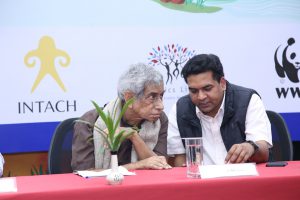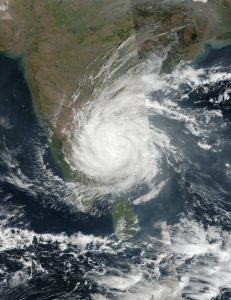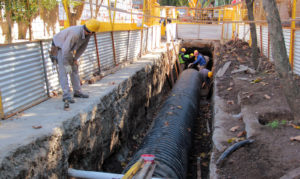Nestled in the mountains of north-eastern Himalayas, Manipur, a bio-diversity rich state in India, has become synonymous as “the powerhouse of the country”. As a consequence huge dams are coming up, restricting the rivers, threatening the region’s fragile ecology, the local economy and the livelihoods of the people. Even worse, these dams are often constructed ignoring the rights of the indigenous people.
The Citizen’s Concern for Dams and Development (CCDD) has been working relentlessly to lend a voice to the local communities in India’s north-east region which hardly gets any space in the mainstream media.
For its exceptional efforts in sensitising the people of Manipur about the implications of mega hydroelectric projects like Loktak, Tipaimukh, Mapithei in the Barak and other river basins and for empowering people to fight for environment and social injustices, CCDD was awarded the “Bhagirath Prayaas Samman” at the India Rivers Week held between 28-30 November at WWF-India, Delhi.
![Dominic Huimi Kashung receiving the “Bhagirath Prayaas Samman” at the India Rivers Week [image by SANDPR]](/wp-content/uploads/2016/12/ccdd.jpg)
Dominic Huimi Kashung (DHK): Tipaimukh is a 1,500 MW project that was first commissioned in 1980s (proposed to be built just 100 kilometres from the Bangladesh border). The dam would have destroyed vast forest land and affected fisheries and livelihoods. So we started raising awareness about it and we managed to unite people for the movement. This put the pressure on the government, and the dam did not receive the clearance, and construction was stopped.
(Manipur falls in the Indo-Burma Biodiversity hotspot and it is estimated that over 8 million tress and 4 million bamboo groves could be permanently destroyed because of submergence due to the dam.)
JC: But given that more mega dams are coming up, what is the ground situation right now?
DHK: I would like to add that the existing dams are failed dams. They are non-performing dams. There is no water for irrigation and breaches of canals often happen. And coming back to your question, I want to tell you how people are suffering because of the huge Mapithel dam.
The aim is to produce 7 MW of energy, to supply water to Imphal and to provide irrigation facilities. Since 10 January 2015, the Mapithel dam has blocked the flow of the river (Thoubal river in Ukhrul district of Manipur). Six villages have been badly affected and are under water now. Schools and roads are under water. And the government is not giving any attention to the plight of the people.
The initial survey for this dam began in 1970s. We protested but they forced it through. The construction has been ongoing for the last 34 years. And the construction is going on without the forest clearance and the environmental clearance. So we have a case in the National Green Tribunal (NGT) that we filed in 2013. But only those villages that have submerged totally are being given compensation. The other villages that are affected are not being compensated. Their paddy fields are under water, but only those ones are being compensated where houses have submerged, not the paddy fields.
JC: How badly has this affected the livelihoods and earnings of people?
DHK: The most serious problem that we are facing right now is that before this dam came up, we had a lot of paddy fields. From these paddy fields, we would get 100-200 tonnes of rice for the whole year. Any extra that would be harvested would be used to support children. Since the last two years there is no rice. The paddy fields have been submerged. So, children are not going to school.
JC: But don’t they often say that these projects would bring economic and infrastructure development locally?
DHK: These are all false promises. The reality is that there is an acute shortage of food. All those crops have been getting flooded since 2015. The transport system is devastated. The roads have been submerged and we have been cut off. We have just two boats for the six villages that we use for ferrying goods and transportation.
There is no income. We have started cutting down trees to sell, so there is a lot of deforestation. Earlier, the river was our source of income. We sold sand, stones, chips, we sold fish, we grew crops along the banks but all the sources of income have been totally destroyed. Economically we have become very poor.
And, there are social and cultural impacts too. In my village, we have no place for worship. We have two main festivals – one is the sowing festival and the other is post-sowing festival. So we cannot celebrate now. There is no harvest (laughs), so how will you celebrate it? There are many students who are dropping out of schools. Their parents can’t support them so they have switched to drugs and alcoholism.
JC: How do the government officials react when you approach them?
DHK: We petitioned them, but they turn a blind eye. We have approached them many times. We have done protests too. One lady was hit by tear gas and she became abnormal after the episode. They deploy a lot of military near the dam so that the public movement gets prevented.
JC: In the case of Tipaimukh, the construction work got stalled due to people’s movement, but in the case of Mapithel, the construction is ongoing for years despite protests. What is the difference between the cases?
DHK: In the case of Tipaimukh people were aware, a momentum was built and people were sensitised about the impacts of dam. In the case of Mapithel dam, people were ignorant so they accepted compensation in 1993. Tipaimukh was still in the initial stage when we campaigned against its impacts. People immediately grasped all the terrible impacts of the dam on society, culture, on the land and on forest. We went from village to village and we apprised them about the problem and impacts of dam and as a result there was a big protest from the civil society and they had to take up public hearing where majority of the people said no.
JC: You have been associated with the campaign for more than ten years. What compelled you to join this in such a big way?
DHK: I wanted to do something for the good of society and wanted to help them out. So I took an interest in this social issue and felt it is important to educate people because majority of the people are ignorant. I feel it is my duty to make people aware.
JC: Is the youth as much connected with the movement?
DHK: It is the youngsters, modern educated people who are taking a keen interest. After that it is the simple farmers who don’t have much learning but who are emotionally attached to the land who are also core part of the movement.
JC: All these years you have seen rivers changing, being diverted due to dams and being impacted due to changing climate. When today we usually see a river just as a source of water, what vision do you hold for the river? How should a river be seen?
DHK: As we have discussed earlier, I want the river to flow naturally because disturbing the natural course of the river has brought a lot of changes, mainly in the climate. My village was temperate before this dam came up but now it has become cooler in the winter and much warmer in summers. Apart from this, lot of diseases are increasing like dysentery, diarrhoea, skin diseases. There are many snakes now because habitat has been disturbed. I want the river to be protected. I want forests to be protected. 595 forests are to be impacted just for one dam (Mapithel). This is very huge and government didn’t even inform the people living in the catchment area that at least 44 villages would be impacted. It will be a failed dam. The impact is so heavy that people were not even informed and suddenly the river was blocked. They were caught unaware.
JC: How difficult is it to sustain such a campaign against all odds? It must be a daily battle.
DHK Very tough. The government has their own machinery. They have power, money and also the security forces. So, to fight them is difficult. It is very difficult against all these resources on the other side. We need courage, we need patience. At times, we receive a lot of criticism from even within the village, and not just the government and that gets discouraging. It is the court that would give justice, sooner or later.
![<p>A school submerged due to the Mapithel dam [image from Stop Mapithel Dam Facebook page]</p>](https://dialogue.earth/content/uploads/2016/12/school-submerged-due-to-Mapithel-dam.jpg)

![Biomass burning is a major source of air pollution. [photo by Ahron-de Leeuw]](https://dialogue.earth/content/uploads/2016/12/Varanasi-ghat-Ahron-de-Leeuw-300x199.jpg)





